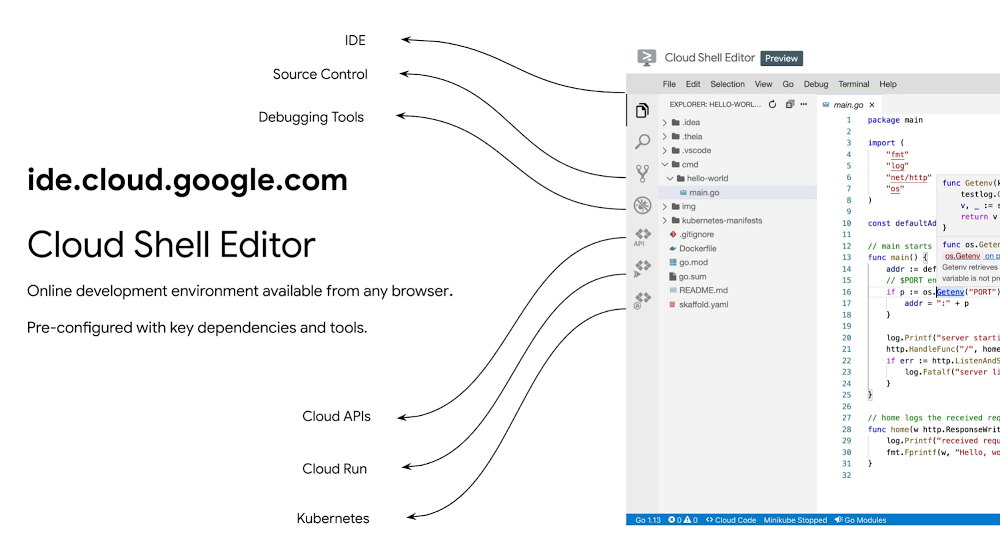New Cloud Shell Editor: Get your first cloud-native app running in minutes
As enterprises move their applications and services to the cloud, developers frequently find themselves evaluating and experimenting with new technologies to identify the best solution to solve their day-to-day problems. This evaluation process could include tasks such as: identifying which platform to host or migrate an application to, or learning how to use an API to implement a new feature.However, we know from talking with you that you frequently spend more time than expected in this initial evaluation phase, doing things such as:Getting your development environment set upFinding the the right libraries and dependencies Switching back and forth between documentation, your Integrated Development Environment (IDE), terminal, and the Google Cloud Console In addition, making these kinds of configuration changes to your daily development environment could impact your core work—something you probably want to avoid. Cloud Shell provides you with command-line access to your cloud resources directly from your browser. And today we’re excited to introduce a new version of our Cloud Shell Editor, immediately available in preview on ide.cloud.google.com and powered by the Eclipse Theia IDE platform. This new version extends Cloud Shell with an online development environment that includes:Cloud-native development via Cloud Code plugin supportRich language support for Go, Java, .Net, Python and NodeJS Additional features such as integrated source control and support for multiple projectsUnder the covers the Cloud Shell Editor development VM comes pre-configured with all the tools you need to get going with cloud-native development on Google Cloud, including:Local emulators for Kubernetes and serverless, andCommand line tools for working with cloud-native appsCloud Shell Editor is a fully functional development tool that requires no local setup, and is available directly from the browser. Let’s take a deeper look at how Cloud Shell Editor integrates with the rest of the Google Cloud developer ecosystem.Samples with interactive tutorialsWe’ve extended our online interactive tutorial platform to include the Cloud Shell Editor features, making initial experiences with a new platform a breeze. You can try it out now with our quickstarts:Google Kubernetes EngineCreate and deploy a containerized web app with Cloud Shell EditorCloud RunCreate and deploy a Cloud Run serverless service with Cloud Shell EditorCloud Code integration for cloud-native developmentCloud Code is a set of IDE plug-ins originally available for IntelliJ and VS Code that helps developers stay productive when developing cloud-native applications, and we’ve now extended it to support the Cloud Shell Editor. Cloud Code offers capabilities such as: an integrated Kubernetes and Cloud Run development and debugging environment; container tools such as minikube, Skaffold, Buildpacks and Jib integrated under the hood to provide local emulators and continuous feedback for faster local development; and an integrated API explorer to make it easy to incorporate Google APIs into your application.Rich language supportIn addition, to support day-to-day development tasks, Cloud Shell Editor now includes advanced language support for Go, Java, .Net, Python and Node.js out of the box, providing powerful editing features such as syntax highlighting, code suggestions, linting, code navigation, refactoring, testing and intuitive debugging support.Version control and support for multiple projectsLast but not least, to simplify team collaboration and work across multiple projects, we’re introducing integrated source control via Git and support for IDE workspaces, leveraging existing Theia development features. For example, you can perform typical source control tasks directly from Cloud Shell Editor such as exploring code samples, cloning a repository or pushing your changes back to a repository. You can also easily create or switch between projects via workspaces, which defines IDE and debugging environment configuration directly in the source.Get started todayWith Cloud Shell Editor, we want to make it easy for you to explore new cloud technologies, prototype applications or do short-term development tasks directly from your browser. We invite you to try the Cloud Shell Editor via our GKE and Cloud Run quickstart, or access it directly from ide.cloud.google.com.
Quelle: Google Cloud Platform


